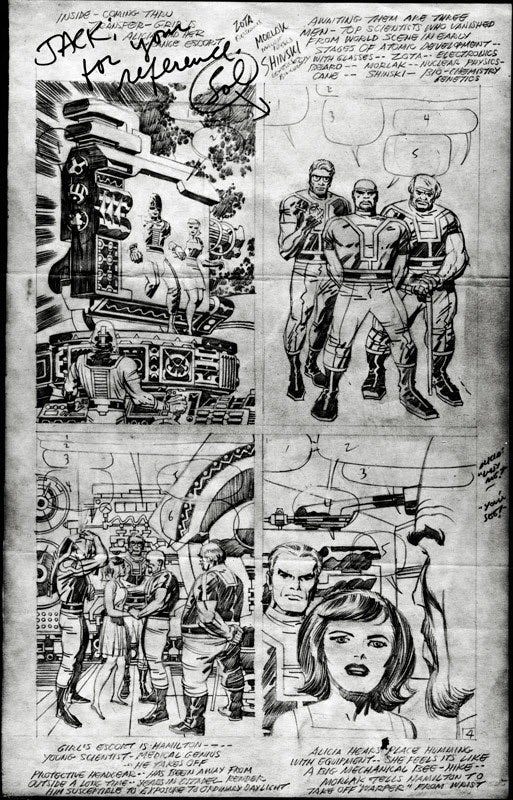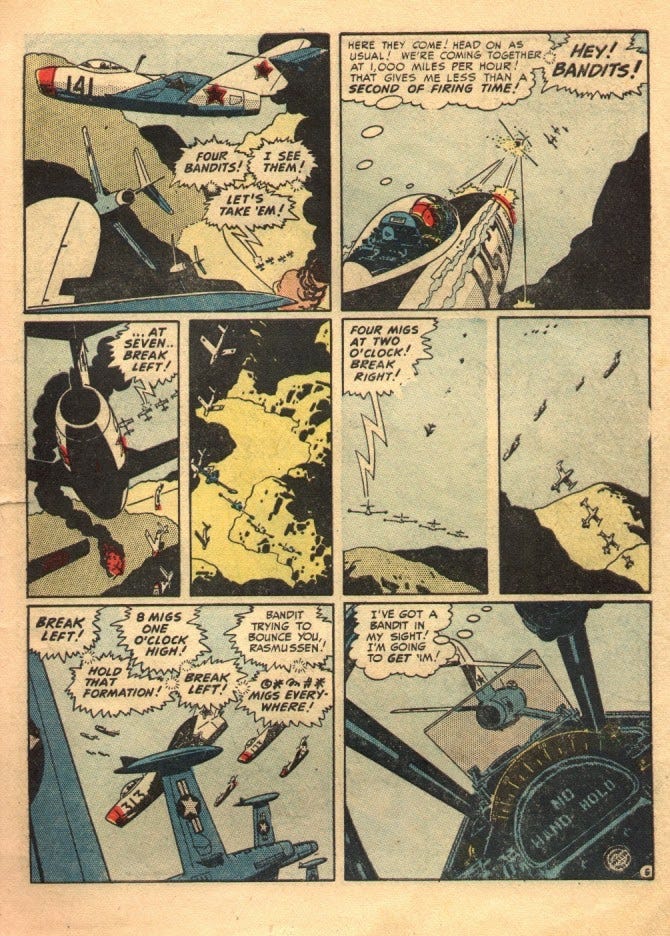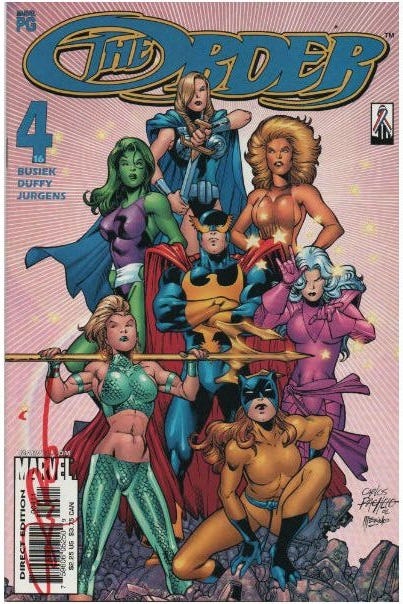After last week’s piece on Neal Adams, I really didn’t want to do another one of these quite so soon. And yet, we all knew that it was coming, and so are prepared for it as much as anybody can be. On Friday night, May 6, George Perez left this world.
I worked with George an awful lot over the years, on a variety of projects. And yet, I find myself really having nothing much to say that doesn’t simply echo the many tributes and memorials that have started to pop up all across the internet. Yes, he was phenomenally talented, and my favorite super hero artist growing up. Yes, he was a person of great personal generosity and zeal, who gave of himself for charitable events and the like. Yes, he was an omnipresent presence at conventions, where he enjoyed interacting with his fans on a one-to-one basis. George was one of those people who did not disappoint.
I could tell you some personal stuff—how I first met him at an early signing for NEW TEEN TITANS at a comic shop on Long Island back in 1981, how he once left me a voicemail message that sounded like one of the Chipmunks after he’d been sent a xerox copy of a key piece of artwork being returned to him rather than the original (an original that he’d already arranged to sell for five figures)—but that stuff all somehow seems a bit reductive to me. I don’t have anything special to tell you about George Perez that you don’t already know if you ever met the man in person, or read one of the comics that he drew or wrote.
Life is temporary.
Behind the Curtain
.Hey, let’s talk about some comic book stuff, huh?
Above is a copy of a penciled page to FANTASTIC FOUR #66 by Jack Kirby. This particular copy was sent back to Jack for reference on the four scientists he’d created to run the super-secret scientific “Beehive” where Him—later Adam Warlock—was being cooked up. It’s pretty pure, uncut Kirby, with no inker interpreting the King’s lines. Additionally, you can see the extensive border notes as to the particulars of the story that Kirby would write out for editor Stan Lee, so that Lee would understand what was going on when it came time to dialogue these pages. While he would have discussions with Lee in an editorial capacity about the direction certain events would take and where the storylines were going, in practice, by the metrics we would use today for apportioning credit, Jack was plotting most of the stories he worked on, particularly after the earliest Marvel years. Stan was dialoguing everything, to be sure, and he would occasionally suggest an idea or have Kirby change up what he was doing. But he wasn’t really driving the series the way Kirby was.
This story is a good example of that. According to legend, it was inspired by a conversation that Kirby had with his fellow artist Steve Ditko. Ditko had come under the spell of Ayn Rand’s philosophy of Objectivism. Ditko believed in these ideas strongly, but Kirby was skeptical. And thinking about them led to the idea of a story in which a quartet of scientist attempt to create the perfect human being, a man without flaws, the Objectivist ideal personified. And in the end, that ideal man would have no use for nor place any value in those flawed beings who had created him, and he would wipe them out almost incidentally. Lee, though, changed the story partway through, making it conform better to commercial super hero comic book ideals. The four scientists became bad guys rather than misguided good guys, and their comeuppance at the hands of a superior power was turned into righteous retribution for them having tampered with forces than mankind wasn’t meant to understand. In this manner, the point of Kirby’s story, his critique of Rand’s Objectivism beliefs, was lost. These were the sorts of difficulties that steadily made Kirby grow more and more dissatisfied at Marvel.
Pimp My Wednesday
My office has one book being released to comic shops this week, the delayed first issue of MOON KNIGHT: BLACK, WHITE & BLOOD. Like the earlier BWB projects, this one is also an anthology of stories by different creators, each team limiting their palate to only black, white and red. I love putting together anthologies like this one, but they simply aren’t huge sellers—readers of today demand that the stories that they’re reading “matter” more concretely to the ongoing canon. This particular anthology was more of a bear than most, and I had to line the whole thing up a few different times, as stories ran late or fell out entirely. But I’m not unhappy with the outcome. This first issue includes a vaguely hallucinatory story featuring the Moon Knight of the future by the always-interesting Jonathan Hickman and the stylistically supreme Chris Bachalo. Hickman loves Bachalo’s work, so the way to get him to participate was as simple as pairing him up with Chris. The second tale is a fun, bouncy team-up between the Crescent Crusader and Spider-Man by new creators Murewa Ayodele and Dotun Akande. Murewa and Dotun had sent me a link to their webcomic series "My Grandfather Was A God" at exactly the point at which I was looking for people to draft into this series, so they wound up getting the nod even without half trying. (That didn’t stop us from fouling up Dotun’s credit on the cover, though.) And finally, there’s a stylish story told completely in reverse by Marc Guggenheim and Jorge Fornes. My big contribution here was suggesting that the title of the story should be “The End”. So you get three stories, any one of which is probably worth the cover price (as is, I think, the great new cover by Bill Sienkiewicz. Bill is almost a requirement in a Moon Knight anthology given his history with the character.) . What are you waiting for?
A Comic Books On Sale 70 Years Ago Today, May 8, 1962
The passage of time means that most readers of today aren’t really familiar with the EC Comics of the early 1950s. They were a high water mark in the industry at the time, both for the depth of their content and the high calibre of their artistic talent. They were also funny, transgressive, arch and very, very memorable. Different people like different titles in the line: the always-gruesome horror books, the “preachie” stories in the twist-ending suspense titles, the high quality of their science fiction books, and of course the trust-no-one anarchy of the pre-magazine MAD. But to me, the two war titles, the unfortunately named TWO-FISTED TALES and FRONTLINE COMBAT, were my favorites. Editor and cartoonist Harvey Kurtzman was at once meticulous about his reference into all of the hardware, equipment, uniforms and vehicles of every conflict he wrote about, to a degree that might be considered fetishizing them. But at the same time, he was one of the few in the early 1950s who was depicting war—including the then-current Korean War—as a game without winners and losers, black hats or white hats. If his work in MAD was subversive, his war stories were much more nakedly so. Kurtzman was a difficult taskmaster who micro-managed the artists he would employ, giving them all complicated tissue paper layouts which they were required to follow with meticulous precision. That’s probably why the great Alex Toth only wound up doing two or three stories with him before quitting in disgust. (It didn’t really take much to get Alex Toth to express his disgust—but Kurtzman earned it.) And this particular 70 year old issue opened with “Thunderjet”, a story about Korean War-era fighter planes in which there are almost no human figures, only airplanes and sky. Toth made a meal out of it, his devotion towards design and minimalism pushing him to create beautiful shapes and negative space while honoring the essence of Kurtzman’s layouts. I mean, just look at this thing:
A Comic I Worked On That Came Out On This Date
Yeah, this series was a bit of a misfire, but not for lack of trying. The name THE ORDER has taken on an almost mythical reputation at Marvel, in that twice it’s been the name we’ve given to a series when the actual original name wound up unable to be cleared by the legal department. In this case, THE ORDER was supposed to be called OVERLORDS, and it was a follow-up to the short-lived DEFENDERS series that Kurt Busiek and Erik Larsen had done for me. DEFENDERS had run for a dozen issues and been cancelled, but speaking with Kurt, he had an idea about how to continue it and wrap it up—one of the ways in which DEFENDERS didn’t quite come together was that it was being done in a true approximation of the classic Marvel style, where there wasn’t a detailed plot. But this meant that while in theory, each issue had both Kurt and Erik doing their thing, the end result read like neither a Kurt Busiek comic nor like an Erik Larsen comic—it was an odd hybrid that wasn’t greater than the sum of its parts. The conceit of DEFENDERS, since there needed to be some reason why that bunch of characters kept coming together to face down threats when they didn’t really want to be a team at all was that they had been cursed by Gaea, the spirit of the Earth, to come to her defense when the world was threatened. The heroes had no choice, they’d be teleported to the site of the impending disaster against their will. So by the time of THE ORDER (and with some machinations going on behind the scenes) the four cursed Defenders (Doctor Strange, Sub-Mariner, the Hulk and the Silver Surfer) would come to the conclusion that the only way to loophole their way out of the curse disrupting their lives was to take over the Earth themselves and thus eliminate any possible dangers that would draw them away. By this issue, motivated to stop their former teammates, Nighthawk, Valkyrie and Hellcat would recruit the female counterparts of the Order to join their fight against them. But there were additional troubles on the horizon. The artist we lined up to take over the series dropped the ball in a big way in terms of his ability to deliver, which resulted in the series having literally a different penciler on each one of its six issues. This issue was drawn by Dan Jurgens, who was then writing THOR for me and also writing and drawing CAPTAIN AMERICA. I don’t know how he found the time, but that explains why he could only jump in to assist on one issue. Additionally, Kurt was a bit under water by this time, so he suggested bringing in a co-writer to help him on THE ORDER in the person of Jo Duffy. Working with Jo was lovely, but as in almost any co-writing situation I’ve run across, the problem lies within the division of labor: one person feels like they’re a hired gun who is meant to be bringing the other person’s ideas to fruition, rather than coming up with ideas on their own. The end result tends to trend toward the middle, towards the safe. Carlos Pacheco did provide the title with some visual unity by drawing all six covers in fine fashion. I don’t know that going with the pink background on this one was necessarily the best choice. It strikes me as somehow being stereotypically feminine, as though because the issue featured a bunch of heroines it should be colored in that manner as well. I don’t love it, looking back. Anyway, this fourth issue came out on May 8, 2002, twenty years ago today, and by this point, I think we all knew that we weren’t going to be continuing on for any more beyond the first six.
Monofocus
The big comic book extravaganza that showed up at my house this week is the massive and slipcased PARKER: THE MARTINI EDITION LAST CALL collecting the last two adaptations of Donald Westlake’s PARKER novels done by the late Darwyn Cooke. Cooke was a hell of a cartoonist and creator, and these PARKER stories were possibly the best things he ever did. I have the original editions, but spring for the oversized collection anway. In part that’s because it also includes a new adaptation by Ed Brubaker and Sean Phillips, as well as a ton of retrospective and behind-the-scenes material about Darwyn and these books. As with the first MARTINI EDITION, it was put together by Scott Dunbier, and is a lovely package that I heartily recommend.
On the broadcast/streaming front, it somehow slipped past me that MADE FOR LOVE had come back for its second season, which meant that I got to binge my way through four episodes of the season in short order. It’s a very weird series, about the wife of a Mark Zuckerberg-esque tech mogul who attempts to escape from her life within his hidden high-tech compound after he develops an implant that will allow him to see through her eyes and secretly has it implanted into her brain. The big sell here for me is star Cristin Milioti, who is terrific in just about everything (and is the all-star of the one-off appearance, as proven by her episodes in BLACK MIRROR and MYTHIC QUEST). Milioti elevates any material she’s given to play, and here she’s backed up by a group of memorable weirdos including Ray Romano as her cancer-stricken father who has replaced his dead wife with a sex doll. It’s a show with a strong flavor to it, and a lot of borderline-unlikable characters, but there’s something compelling about it.
Finally, I cannot say enough good things about the debut of STAR TREK: STRANGE NEW WORLDS. It gave me absolutely everything that I wanted, in that it’s a STAR TREK show that doesn’t attempt to reinvent the wheel. I really like the retro-future design aesthetic and the score with its callbacks to the original 1960s series. The cast seems pretty great, including the returning Number One/Una and Spock as well as the recast-for-this-series Uhura and Nurse Chapel. The new characters also seem well-drawn so far. But the glue holding the whole thing together is Anson Mount’s Christopher Pike. He is full-out spectacular, whether in heroic, inspiring captain mode or introspective, troubled soul who is haunted by the visions he saw of his own future fate. After having suffered through the second season of PICARD (which pulled itself together for a final episode which, while it still didn’t make much narrative sense, was at least was smart enough to lean into its emotional beats in a satisfying way—truly, we will forgive a story for anything if it delivers the feels) I was all-in on this first episode, and hope that the team can maintain this level of quality through the entirely of the season.
That’s about it for this time, I think. As always, thanks for your interest and your support. So far, this experiment appears to be on track, so you can expect to be receiving these newsletters every week for the foreseeable future.
Tom B










“I love putting together anthologies like this one, but they simply aren’t huge sellers—readers of today demand that the stories that they’re reading “matter” more concretely to the ongoing canon.”
I am probably not the type of reader you refer to. I love anthologies. I find they provide unique perspectives on the characters and introduce me to new creators. I have edited 3 anthologies and hope to do many more.
Thank you for continuing to do them even though they are not your best sellers.
Thank you for this, Tom.